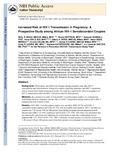Increased Risk of HIV-1 Transmission in Pregnancy: A Prospective Study among African HIV-1 Serodiscordant Couples

View/
Date
2011Author
MUGO, Nelly R
HEFFRON, Renee
DONNELL, Deborah
WALD, Anna
WERE, Edwin O
REES, Helen
CELUM, Connie
KIARIE, James N
et al
Type
ArticleLanguage
enMetadata
Show full item recordAbstract
Background
Physiologic and behavioral changes during pregnancy may alter HIV-1 susceptibility and infectiousness. Prospective studies exploring pregnancy and HIV-1 acquisition risk in women have found inconsistent results. No study has explored the effect of pregnancy on HIV-1 transmission risk from HIV-1 infected women to male partners.
Methods
In a prospective study of African HIV-1 serodiscordant couples, we evaluated the relationship between pregnancy and the risk of 1) HIV-1 acquisition among women and 2) HIV-1 transmission from women to men.
Results
3321 HIV-1 serodiscordant couples were enrolled, 1085 (32.7%) with HIV-1 susceptible female partners and 2236 (67.3%) with susceptible male partners. HIV-1 incidence in women was 7.35 versus 3.01 per 100 person-years during pregnant and non-pregnant periods (hazard ratio [HR] 2.34, 95% confidence interval [CI] 1.33–4.09). This effect was attenuated and not statistically significant after adjusting for sexual behavior and other confounding factors (adjusted HR 1.71, 95% CI 0.93–3.12). HIV-1 incidence in male partners of infected women was 3.46 versus 1.58 per 100 person-years when their partners were pregnant versus not pregnant (HR 2.31, 95% CI 1.22–4.39). This effect was not attenuated in adjusted analysis (adjusted HR 2.47, 95% CI 1.26–4.85).
Conclusions
HIV-1 risk increased two-fold during pregnancy. Elevated risk of HIV-1 acquisition in pregnant women appeared in part to be explained by behavioral and other factors. This is the first study to show pregnancy increased the risk of female-to-male HIV-1 transmission, which may reflect biological changes of pregnancy that could increase HIV-1 infectiousness.
Citation
AIDS. 2011 September 24; 25(15): 1887–1895.Publisher
Department of Obstetrics & Gynaecology
Description
Full text
Collections
- Faculty of Health Sciences (FHS) [10378]
